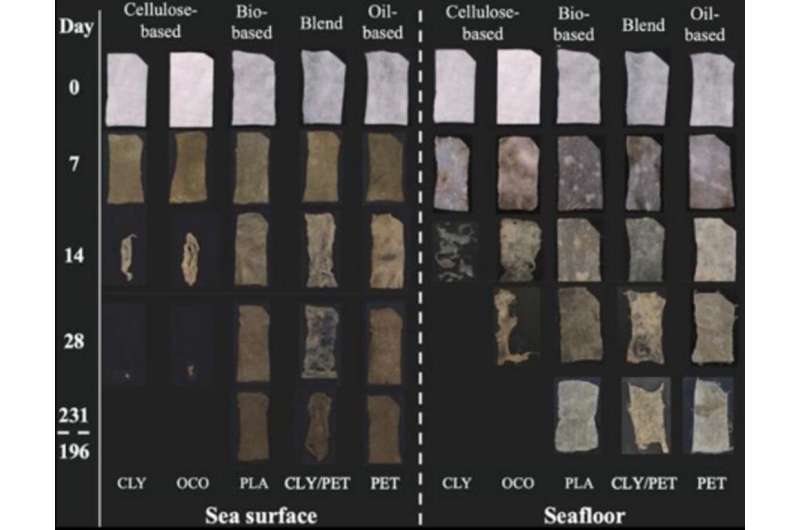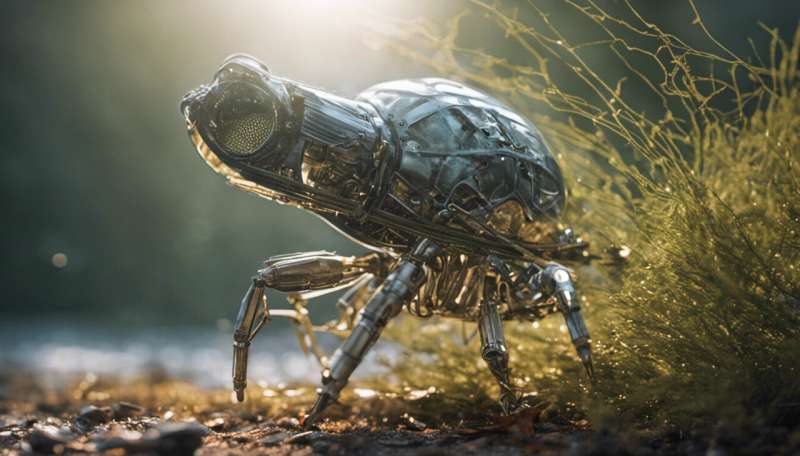This article has been reviewed according to Science X's editorial process and policies. Editors have highlighted the following attributes while ensuring the content's credibility:
fact-checked
peer-reviewed publication
trusted source
written by researcher(s)
proofread
Biodegradable plastic in clothing doesn't break down nearly as quickly as hoped—new research

Plastic pollution has emerged as one of the most pressing environmental challenges of our time. Over 100 million tons of plastic enters the environment each year, with more than 10 million tons ending up in our oceans. These plastics break down into harmful microplastic particles so small they can be consumed by wildlife.
We all recognize discarded bottles and bags as plastic waste. But the synthetic fibers that are woven into our clothing—polyester, nylon, acrylic and others—are equally problematic. Every year, more than 60 million tons of plastic fabric is produced, a considerable amount of which ultimately finds it way to landfill.
One promising approach to tackle this crisis is the use of "biodegradable" plastics. These plastics are designed to break down naturally into gases and water, which are then released back into the environment without causing long-lasting damage.
But the reality of biodegradable plastic (or "bioplastic") falls short of meeting our expectations. New research, led by the Scripps Institution of Oceanography in San Diego, California, has found that a popular bioplastic material called polylactic acid does not break down in the environment nearly as quickly as hoped.
The researchers suspended fiber samples from both bio- and oil-based plastic materials, as well as natural fibers such as cotton, in coastal waters and on the seafloor. Over time, they examined these individual fibers under a microscope to see if they were breaking down. While cotton fibers began to break down within a month, synthetic fibers, including bioplastic materials such as polylactic acid, showed no signs of breaking down even after 400 days submerged in the ocean.
Finding their way into the sea
The plastic pollution that stems from clothing is a particularly tricky area. Clothes are often not recycled or even recyclable, and they release tiny plastic fibers into the environment through gradual wear and tear.

Clothing fibers can reach our oceans via multiple pathways. Clothes that are washed into the sea, for example, will be broken up physically by wave action or friction with sand particles. This process leads to the release of fibers as the garment frays.
Even by just wearing our clothes, plastic fibers are discharged into the environment—some of which may eventually settle in the ocean. And during the process of washing our clothes, fibers become dislodged and are carried down our drains, also potentially ending up the sea.
No matter what we do, clothing fibers will inevitably find their way into the environment. So, it is sensible to give serious consideration to what happens to these fibers once released.
Why does this matter?
Research has found evidence that polylactic acid microfibres are potentially toxic to marine organisms, including jellyfish. The jellyfish studied changed their pulse frequency when exposed to high concentrations of these plastic fibers, potentially reducing their ability to hunt, avoid predators, and maintain orientation in the water.
The presence of polylactic acid fibers in the marine environment may cause jellyfish numbers and behavior to change. Such changes could have far-reaching implications for marine ecosystems. Jellyfish are widely distributed across all oceans and play a crucial role in the marine food web, both as predators and prey.
The longevity of polylactic acid fibers in the marine environment is another concern. The longer these fibers remain in the environment, the more likely it is they will be eaten by marine organisms.

Bioaccumulation, where microplastics and their associated chemicals accumulate across a marine food web, is then likely to occur. Research has found evidence of microplastic bioaccumulation across multiple species and microplastic types.
Tackling plastic pollution
No matter how the plastic enters the environment, solutions are needed to tackle plastic pollution. Biodegradable plastics are one potential option, but only if they are made from materials that are truly able to break down quickly in the natural environment. They would reduce the time in which plastic materials spend in the environment.
As with conventional plastics, though, bioplastics must still be disposed of correctly. But research has found that the labels and instructions on many biodegradable products are often confusing and misleading. In a study of 9,701 UK citizens, many reported not having understood the meaning of the labels of degradable, compostable and biodegradable plastics.
This could lead to biodegradable and non-biodegradable plastics being disposed of incorrectly. Plastic that is released into the environment may not decompose, and will instead break down into small pieces of microplastic.
Polylactic acid can break down in specialized industrial composting plants. But even then, not all composting processes can handle every type of bioplastic. The plastic material has to meet specific criteria and produce compost of a minimum standard.
As the world uses more biodegradable plastic, we need to make sure this material's environmental footprint is minimized. With that in mind, improving labeling and disposal instructions and improving access to industrial composting could all help.
More information: Sarah-Jeanne Royer et al, Not so biodegradable: Polylactic acid and cellulose/plastic blend textiles lack fast biodegradation in marine waters, PLOS ONE (2023). DOI: 10.1371/journal.pone.0284681
Journal information: PLoS ONE
Provided by The Conversation
This article is republished from The Conversation under a Creative Commons license. Read the original article.![]()





















